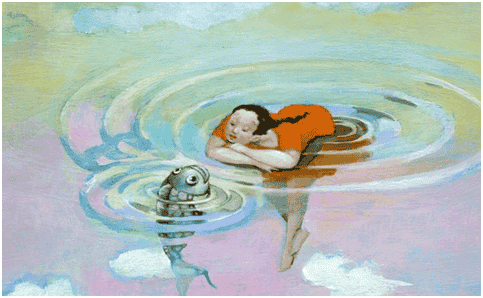
Last update: 11 November 2017
Did you know that it is possible to trick the brain to create a moment of happiness? Yes, happiness is an emotion / emotional state that we can attract, even in circumstances that apparently seem less propitious for its arrival.
It has been known for a long time that emotions are accompanied by various changes in the body, such as the increase in heart rate or the tension of some muscles of the face responsible for that gesture that we like so much: the smile.
One thing that has recently been discovered, however, is that it is a two-way street. We can fool the brain by implementing some physical reactions that result from specific emotions, so as to facilitate the onset of emotion starting from the reactions.
By smiling we can attract a moment of happiness
Expressing emotions is a two-way street. The brain is attentive to what the body is doing, and this affects our emotions. The simple fact of smiling, even for no reason, helps the body to reach a moment of happiness that brings with it great benefits.
As much as a circumstantial smile is, in technical terms known as the facial feedback hypothesis, it doesn't just involve the facial muscles, it goes further and brings good news. While it is sometimes difficult to control our emotions, controlling our muscles is much easier.
Let us remember that the smile is a powerful tool. Most people think that you smile only because you are happy, but the opposite may also be true: you are happy because you smile.
To get a moment of happiness in a very simple way, but also of tranquility and security, it is enough to sketch a smile.
Facial feedback hypothesis
To many it will seem absurd that a simple smile can attract an emotion as intense as happiness. But it can't be that absurd if science has devoted multiple experiments and research to analyzing the facial feedback hypothesis.
One of the best experiments to prove this hypothesis was carried out in the late 80s. The scholars did not want to influence the results by telling the test subjects that the study had to do with emotions, so they found an ingenious solution to tense certain muscles of the face without knowing the ultimate purpose of the request.
The study participants had to hold a pencil with their mouth in certain ways, 3 different ones specifically. The first group held the pencil horizontally between their teeth, forcing a smile. The second held it vertically with his lips, so that he could not smile; on the contrary, their posture forced them to frown slightly. The control group held the pencil in their hand.
At that point the subjects looked at some caricatures and said if they found them funny. The group forced to smile gave the caricatures much more "funny" adjectives than the frown group, while the control group gave intermediate adjectives.
In a more recent study, participants were presented with different faces, which had happy, neutral or pouting expressions. The subjects were told that the study was aimed at measuring the reaction time of the facial muscles, but in reality they were studying emotions. Regardless of the image, subjects had to either "raise their cheeks" (smile) or "twitch their eyebrows" (frown).
The facial expression required affected how the images were perceived. When they smiled, the subjects found the images more pleasing than when they frowned. Also, the effects of the smile lasted until later.
The Facial Feedback Hypothesis states that facial movement can affect the emotional experience.
Forced smile, real happiness
Facial feedback works because the brain detects the tension of certain facial muscles (like the major zygomatic and minor zygomatic, necessary for smiling) and interprets it as a sign that there is a reason to be happy. Likewise, if this muscle is not under tension, the brain thinks it is not the time to be happy.
And that's not all. In addition to the facial feedback we get physically on an individual level, there is another factor that affects the emotion of happiness: social feedback. Smiles are contagious. Even when we don't feel particularly happy, if the people around us smile, we probably will too, thus improving our mood.
If we strive to enhance this energy so that it makes us smile, especially when we are with other people, the benefit will be greater, because we will charge the environment with positive vibrations, favoring the creation of an environment in which it is easier to be happy.
If we really want to get the most benefit from facial feedback, we need to find something to laugh about or just lift the corners of the mouth to fool the brain. What is initially a forced smile will soon become a sincere smile. And immediately our happiness will also be sincere.
No matter where we are, this little moment of happiness will make it easier for us.


























